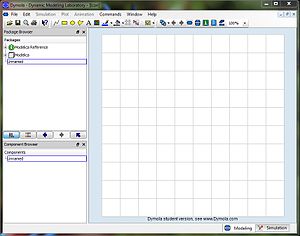- Dymola
-
Dymola 
Developer(s) Dassault Systemes AB, Lund, Sweden Stable release 2012 / June 10, 2011 Operating system Microsoft Windows, Linux Type Modelica implementation License Proprietary Website Dymola Dymola is a commercial modeling and simulation environment based on the open Modelica modeling language. It is developed by the Swedish company Dassault Systèmes AB, Lund (a subsidiary of the shareholder company Dassault Systemes). Dymola is available as standalone product, as well as integrated in CATIA Systems V6.[1]
The latest 2012 version of Dymola supports version 3.2 of the Modelica language.
Contents
History
The first version of Dymola was initially designed in 1978 by Hilding Elmqvist, for his PhD thesis[1] at Lund University (in 1978 called Lund Institute of Technology). This first version of Dymola was based on the Dymola modeling language and was implemented in Simula 68. Later it was re-implemented in C++. In 1991, Hilding Elmqvist created the Swedish company Dynasim AB to continue the development of Dymola. In 2006, Dassault Systèmes acquired Dynasim and started to integrate Dymola in CATIA. In 2010, Dassault Systèmes AB, Sweden was created and Dynasim AB is now part of this subsidiary of Dassault Systèmes.
In 1996, Hilding Elmqvist initiated the Modelica design effort. The goal was to develop an object-oriented language for modeling of technical systems in order to reuse and exchange dynamic system models in a standardized format. Modelica is based on the Dymola language, but the experience with the Dymola language and with other modeling languages have been taken into account. In September 1997, version 1.0 of the Modelica specification was released which was the basis for a prototype implementation within Dymola. In year 2000, the non-profit Modelica Association was formed to manage the continually evolving Modelica language and the development of the free Modelica Standard Library. For some transition period, the Dymola software supported both the Dymola and the Modelica language. Since 2002, only the Modelica language is supported.
Applications & Libraries
Dymola has unique multi-engineering capabilities which means that models can consist of components from many engineering domains. Libraries in many different engineering domains contain components for mechanical, electrical, control, thermal, pneumatic, hydraulic, power train, thermodynamics, vehicle dynamics, air -conditioning, etc.
Model Design Tools
- The Model Calibration option is based on a process where measured data from a real device is used to tune parameters such that the simulation results are in good agreement with the measured data.
- The Design Optimization option is used to tune parameters of a device or its controller to improve system dynamics for multiple criteria and multiple cases.
- The Model Management includes support for encryption of models, version control from Dymola and utilities for checking, testing and comparing models.
Libraries
- The Powertrain Library (designed, implemented, and maintained by DLR, the German Aerospace Center, Institute of Robotics and Mechatronics in Oberpfaffenhofen) contains components to enable the simulation of the whole powertrain system including the resulting motion of the vehicle. This enables the prediction of attributes such as vehicle performance, fuel economy and driveability. The library provides components of varying detail to model transmissions, drivelines and the longitudinal vehicle dynamics plus driver models for carrying out different tests.
- The Vehicle Dynamics Library (developed, supported, and maintained by Modelon AB) is used to simulate vehicle dynamics behavior and handling and contains components such as tires, driver models, struts, wishbones, and anti-roll linkages as well as complete front and rear suspensions.
- The Smart Electric Drives Library (designed, implemented, and maintained by AIT, the Austrian Institute of Technology) allows modeling and simulation of an entire electric drive systems and is ideal for simulation of hybrid electrical vehicles and new alternative concepts with electrical auxiliaries.
- The Hydraulics Library (developed, supported, and maintained by Modelon AB) is a powerful yet simple-to-use tool including models of pumps, motors, cylinders, restrictions valves, hydraulic lines, lumped volumes and sensors.
- The Pneumatics Library (developed, supported, and maintained by Modelon AB) provides basic model classes for the modeling of cylinders and motors, valves and nozzles, lumped volumes, lines and sensors.
- The Air Conditioning Library (developed, supported, and maintained by Modelon AB) is a full-featured model library for refrigeration and A/C cycles with typical working media such as R134a and even CO2.It contains advanced two-phase flow and air handling models for all design phases from conceptual design to control implementation.
Code and Model Export
For most steps during system development (dimensioning, detailed design , implementation), it is important to have access to a C code image of the model in order to run HardWare in The Loop, Rapid prototyping simulations or to build simulators for validation or training purposes. Several options are available to achieve those activities.
Interfacing with other Software
- Interfacing to CAD : Real-time 3D animation and import of CAD files.
- Interfacing Dymola and SIMULIA software : It is possible to interface Dymola and the SIMULIA tools Abaqus, iSight and Fiper for cosimulation purposes for instance.
- Interfacing Dymola and Simulink
- Import of Simulink models using the Functional Mock-up Interface standard defined in the MODELISAR project
- Export to Simulink by generation of S function (using the Simulink Interface option)
See also
- Modelica
- MathModelica
- SimulationX
- MapleSim
- AMESim
- EcosimPro: Continuous and Discrete Modelling and Simulation Software
References
External links
Categories:- Simulation programming languages
- Simulation software
Wikimedia Foundation. 2010.

